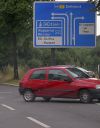Germany
| Germany Deutschland | |||||||||||||||
| Location Map ( geo) | |||||||||||||||
| |||||||||||||||
| |||||||||||||||
| Signage colour | |||||||||||||||
| |||||||||||||||
| Units | |||||||||||||||
| |||||||||||||||
| General data | |||||||||||||||
| |||||||||||||||
| Borders | |||||||||||||||
| Austria, Belgium, Czech Republic, Denmark, France, Luxembourg, Netherlands, Poland, Switzerland | |||||||||||||||
Introduction
Germany is a middle-sized country in central Europe. It has a population of 81.5 millions and a surface area of 357,376 km². Its capital city is Berlin.
Germany borders nine different countries: Denmark in the north; the Netherlands, Belgium, Luxembourg, and France in the west; Switzerland and Austria in the south; and the Czech Republic and Poland in the east. It is furthermore bounded by the North Sea and the Baltic Sea in the north. The topography of Germany ranges from flat lowlands in the north to mountains in the very south. Two thirds of the country are covered by low mountain ranges.
Although the two largest cities, Berlin and Hamburg, are located in the northern lowland the majority of the population lives in the south and the west of the country. This tendency is intensified by the division of the country after World War II which initiated a gradual decline of the east German population.
Germany is a federal country, made up of 16 states. It is a member of the European Union and a part of the Schengen area.
Road network
Numbering
Motorways
German motorways are famous the world over. Although approximately 40% of the 12,845 km of motorways [1] are limited to 130 km/h or less, the other 60% have no explicit speed limit. The single-digit motorways are the major cross-county routes while double-digit numbers are more regional in nature. The current numbering system was introduced in 1974.
28 border crossings connect the German motorway network with each of its nine neighbouring countries: a circumstance reflecting its central position in Europe and the importances of the country as a transport hub.
Bundesstraßen (federal roads)
Along with the motorways Bundesstrassen form the nationwide network of trunk routes which are built and maintained by the federal government. The maintenance of Bundesstrassen within towns with populations over 80,000, however, remains an obligation of the local municipalities concerned. This federal trunk route network connects all towns of significance. With the expansion of the motorways, however, the total length of Bundesstrassen is shrinking as Bundesstrassen are transferred to the custody of the respective Land once their trunk status has been taken over by a nearby motorway.
There were approximately 39,700 km of Bundesstrassen in Germany at the end of 2012 (Source:[2]).
Bundesstrassen come in all shapes and sizes, ranging from full-blown motorway standard to winding nearly natural 2-lane roads. While the bulk of the Bundesstrassen network is made up of all-purpose roads some roads are marked as Kraftfahrstrassen, a legal term covering the application of motorway restriction to non-motorway roads.
Landesstraßen (state roads)
These roads are maintained by the 16 states of Germany.
Driving
Speed limits
- motorways: none (130 km/h recommended)
- dual-carriageway roads: 100 km/h
- single-carriageway roads: 100 km/h
- built-up areas (except on motorways): 50 km/h
Priority
The basic principle of priority on German roads is priority to the right. Unless otherwise stated the vehicle from the right has the right of way at junctions. In practice this rule is implemented only at junctions lying off the main road network in residential areas and on industrial estates.
Main roads, however, are almost always clearly marked as priority routes which are given priority over side roads along their whole route.
The main carriageway of grade-separated roads always has priority over traffic joining from link or slip roads, just as the circular path of a roundabout has priority over all joining junction approaches.
Links



